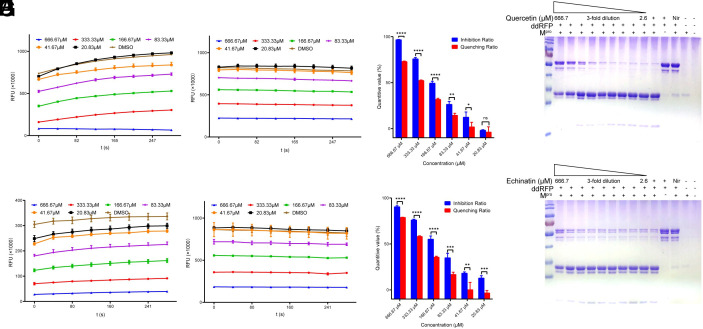Recently, we published an article (1) showing that several bioactive compounds were identified from Huashi Baidu decoction (Q-14) that showed both antiviral activity and anti-inflammatory effects against COVID-19. The main protease (Mpro) of SARS-CoV-2 is an attractive target for the development of antiviral drugs. Our results showed that quercetin and echinatin from Q-14 displayed moderate inhibition activities against SARS-CoV-2 Mpro at submicromolar levels by the fluorescence resonance energy transfer (FRET)–based protease activity assay. However, Yan et al. suggested that quercetin is a promiscuous Mpro inhibitor because of its fluorescence quenching effect (2).
We took this suspicion very seriously. Therefore, we repeated the FRET-based protease activity assay and tested the fluorescence quenching effects with the MCA-AVLQ-Lys (Dnp)-Lys-NH2 (MCA-AVLQ) fragment. The FRET assay results showed that both quercetin and echinatin have Mpro inhibition activity (Fig. 1 A and E), but both quercetin and echinatin displayed a fluorescence quenching effect on MCA-AVLQ fragment (Fig. 1 B and F). The inhibition ratio and quenching ratio were further calculated (Fig. 1 C and G). We found that the inhibition ratio is significantly greater than the quenching rate, especially at low concentrations, which indicates that quercetin and echinatin should possess certain Mpro inhibition activity. To further validate the Mpro inhibition activity of these two compounds, we performed an Sodium dodecyl sulfate – polyacrylamide gel electrophoresis (SDS-PAGE) assay of the cleavage of the Dimerization-dependent red fluorescent protein (ddRFP) biosensor, and this method can avoid the interference of fluorescence quenching effects which was also used by Yan et al. (3). We found that quercetin has obvious Mpro inhibition activity at high concentrations (from 166.67 μM to 666.67 μM), using nirmatrelvir (PF-07321332) as a positive control. By contrast, echinatin showed minor Mpro inhibition activity at 666.67 μM (Fig. 1 D and H).
Fig. 1.
SARS-CoV-2 Mpro inhibitory activity of quercetin and echinatin. (A) Inhibition of Mpro by quercetin by the FRET assay. (B) The fluorescence quenching effect of quercetin on MCA-AVLQ fragment. (C) The Mpro inhibition ratio and quenching ratio of quercetin were calculated (*P < 0.05, **P < 0.01, ***P < 0.001, ****P < 0.0001, and ns: not significant). (D) Inhibition of Mpro cleavage of ddRFP by quercetin based on the SDS-PAGE assay. Nirmatrelvir (Nir) was used as a positive control. (E) Inhibition of Mpro by echinatin by the FRET assay. (F) The fluorescence quenching effect of echinatin on MCA-AVLQ fragment. (G) The Mpro inhibition ratio and quenching ratio of echinatin were calculated (*P < 0.05, **P < 0.01, ***P < 0.001, ****P < 0.0001, and ns: not significant). (H) Inhibition of Mpro cleavage of ddRFP by echinatin based on the SDS-PAGE assay. Nirmatrelvir (Nir) was used as a positive control.
In conclusion, we confirmed that quercetin and echinatin showed weak Mpro inhibition activity, although fluorescence quenching effects were observed by Yan et al. (2) and by us here. We cannot rule out the possibility that these two compounds might have other targets to achieve the anti-SARS-CoV-2 effects, which can be further studied in the future. We agree that we should be cautious with our assay methods, and it is necessary to verify the inhibitory activity by different methods due to the limitations of current available methods.
Acknowledgments
Funding for this work was provided by the Key Project at the Central Government Level: The Ability Establishment of Sustainable Use for Valuable Chinese Medicine Resources (2060302), the National Natural Science Foundation of China (81830111), and the Establishment of Sino-Austria “Belt and Road” Joint Laboratory on Traditional Chinese Medicine for Severe Infectious Diseases and Joint Research (2020YFE0205100).
Author contributions
H.X., L.F., and Y.S. designed research; Y.Z. and J.Y. performed research; H.X., L.F., Y.S., L.H., and G.F.G. analyzed data; and H.X., L.F., Y.S., L.H., and G.F.G. wrote the paper.
Competing interests
The authors declare no competing interest.
Contributor Information
Luqi Huang, Email: huangluqi01@126.com.
George F. Gao, Email: gaof@im.ac.cn.
References
- 1.Xu H., et al. , Bioactive compounds from Huashi Baidu decoction possess both antiviral and anti-inflammatory effects against COVID-19. Proc. Natl. Acad. Sci. U.S.A. 120, e2301775120 (2023). [DOI] [PMC free article] [PubMed] [Google Scholar]
- 2.Yan H., Zhang R., Liu X., Wang Y., Chen Y., Reframing quercetin as a promiscuous inhibitor against SARS-CoV-2 main protease Proc. Natl. Acad. Sci. U.S.A. 120, e2309289120 (2023). [DOI] [PMC free article] [PubMed] [Google Scholar]
- 3.Yan H., et al. , Production of a versatile SARS-CoV-2 main protease biosensor based on a dimerization-dependent red fluorescent protein. J. Med. Virol. 95, e28342 (2023). [DOI] [PubMed] [Google Scholar]



